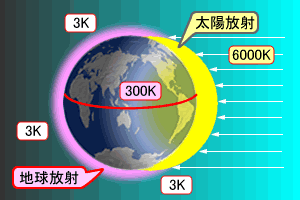⑤エネルギー収支:
太陽放射と地球放射のエネルギー収支
⑥気象観測:
地域気象観測網(AMeDAS)、レーダー観測、気象衛星観測(静止気象衛星、極軌道気象衛星)。
|
セ氏温度をC (℃)、ケルビン温度をK (K)とすると、次の関係が成り立つ: セ氏温度をC (℃)、カ氏温度をF (゜F)とすると、次の関係が成り立つ: ※セ氏:1気圧のもとで溶けつつある氷の温度(氷点)を0度、沸騰しつつある水蒸気の温度(沸点)を100度として、その間を100等分したもの。 |
『〔内容〕
1.気象衛星ひまわりの写真から、大、小の大気の流れを知る。
2.太陽からの熱による、地球の熱の放射をアニメーションでみる。
3.海上に太陽の熱放射が及んだ時の大気の流れと雲の発生、大気への熱放射をアニメーションで示す。
4.緯度別に見た年平均の太陽からの熱の入射量と地球からの熱の放射量についてしらべ、低い緯度の地域では熱が過剰となって熱源となり、極地方では熱が不足して冷源となることを知る。
5.北極の上空からみた北半球の夏、冬の、雲の様子を見せ、太陽の影響がいかに大きいかを知らせる。
6.北極上空から見た暖流と寒流の流れをアニメーションで見、熱の極地域のアンバランスを解消するものとして海流の流れがあることを説明する。
7.大気中での極と赤道との熱のアンバランスを解消するために赤道から極に向って、子午線方向の流れがあることを示す。
8.子午線方向の流れが地球の回転の作用で偏西風、偏東風になることをアニメーションでみせる。
9.円板状にカメラをのせ、円板を回転して球をころがすと、右に曲がる。この実験から地球上の大気も同じ影響を受けることを知る。
10.亜熱帯高圧帯と亜熱帯低圧帯ができるわけをしらせる。
11.海風、陸風を例に太陽からの熱吸収が大きく大気に作用していることをみる。
12.海陸風が大規模になったものが夏、冬、の季節風であることを知らせる。
13.水の大循環から大気と地球の間での熱のやりとりがあることを知る。
14.北極の上空から北半球の高層に於ける大気の流れを17日間の天気図の変化で知る。
15.流体実験により、地球上の大気に大きな流れがあることをたしかめる。』
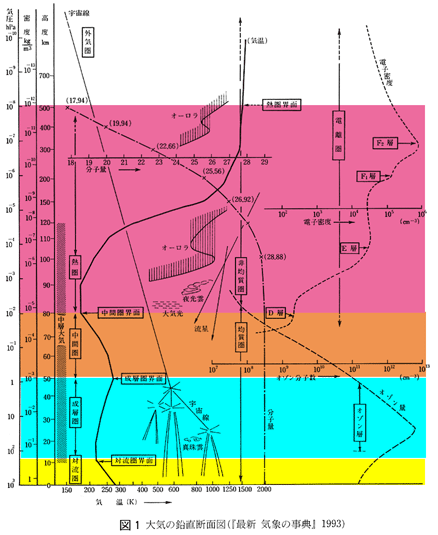 〔三輪剛史氏によるJacso Palaceの中の『気象用語集』から〕 |
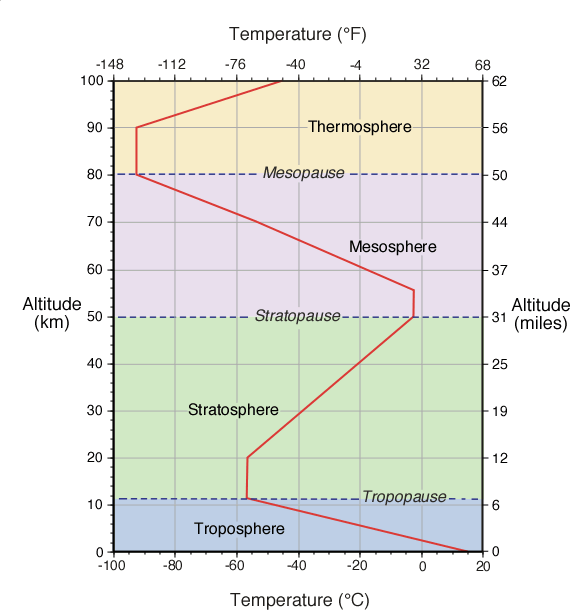 Figure 7b-1: Vertical change in average global atmospheric temperature. Variations in the way temperature changes with height indicates the atmosphere is composed of a number of different layers (labeled above). These variations are due to changes in the chemical and physical characteristics of the atmosphere with altitude. 〔Michael Pidwirny氏によるPhysicalGeography.netの『FUNDAMENTALS OF PHYSICAL GEOGRAPHY』の『CHAPTER 7: Introduction to the Atmosphere』の『(b). The Layered Atmosphere』から〕 大気の温度構造。高度に対して温度は下降と上昇を繰り返しているが、その変わり目を境界として、地表から対流圏・成層圏・中間圏・熱圏と名づけられている。それらの境界は、地表から対流圏界面・成層圏界面・中間圏界面と呼ばれる。成層圏界面付近の温度上昇は、太陽紫外線によるオゾンの生成と分解に伴う発生熱による。なお、オゾン層は高度20~30km付近に存在する。また、熱圏の温度上昇は、大気を構成するさまざまなガス分子の太陽紫外線による電離反応に伴う発生熱による。 |
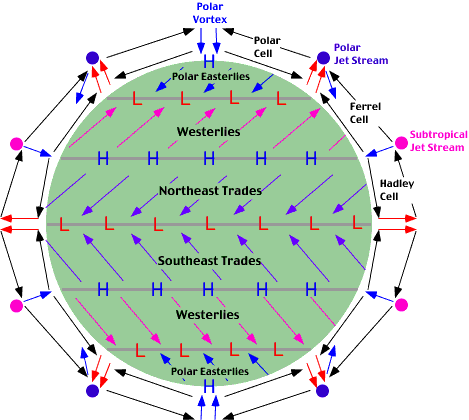 Figure 7p-2: Simplified global three-cell surface and upper air circulation patterns. 〔David Hodell and Ray G. Thomas両氏によるWelcome to the GLY1073 Electronic Tutor: "An Introduction to Global Change"の『Atmospheric Circulation』の中から〕 大気の大循環。 |
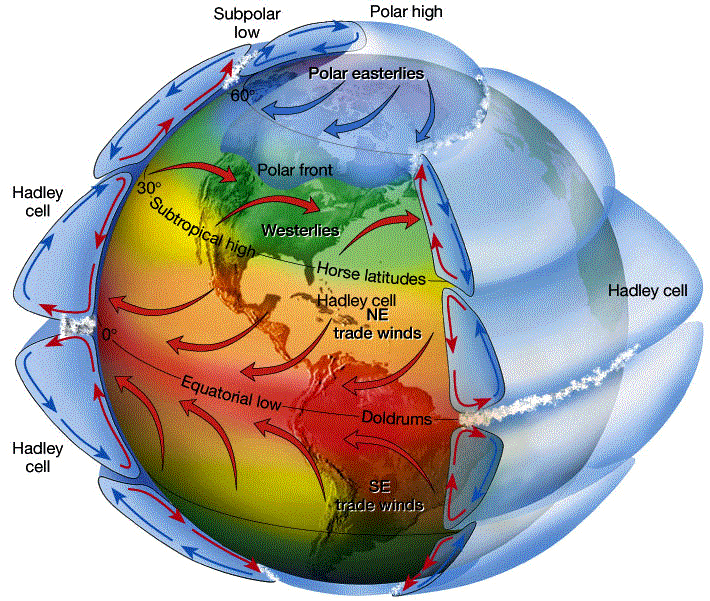 Idealized, three cell atmospheric convection in a rotating
Earth. "Three cell" being either three cells north
or south of the equator. The deflections of the winds within
each cell is caused by the Coriolis Force. 〔Eastern Illinois UniversityのJohn P. Stimac氏による『Weather and Climate ESC 1400G - Sections 7, 8, 9』の『Atmospheric Circulation』から〕 大気の大循環。おもに対流圏であるが、図は誇張されている。北半球においては、赤道側からハドレー循環・フェレル循環・極循環の3つが存在する。南半球にも対称的に3つの循環が存在する。ただし、図は理想化されている。南北方向の大気の動きは、地球の自転の影響を受けて、例えば北半球では進行方向の右側にそれる。南半球では逆である。 |
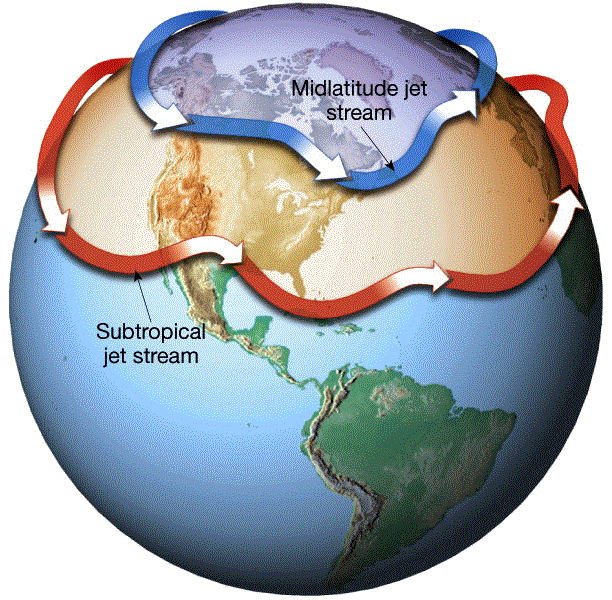 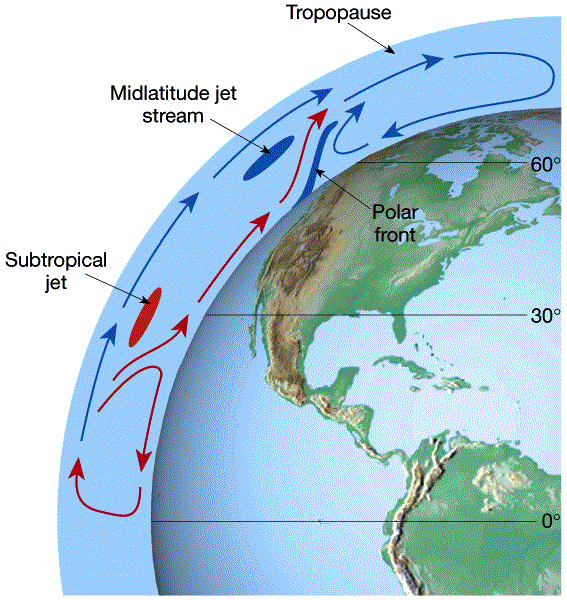 Location in map view (left) and cross-sectional view (right)
of the jet streams. 〔Eastern Illinois UniversityのJohn P. Stimac氏による『Weather and Climate ESC 1400G - Sections 7, 8, 9』の『Atmospheric Circulation』から〕 大気の大循環の中のジェット気流。 |
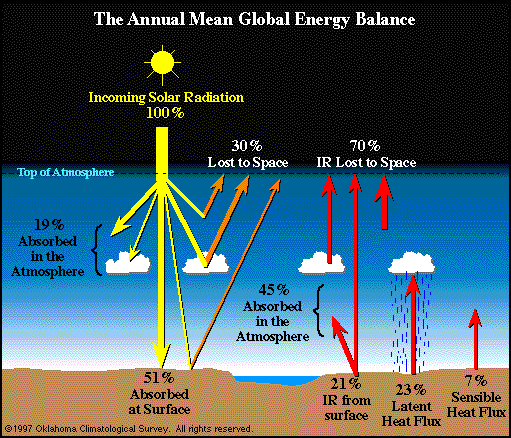 〔Oklahoma Climatological Surveyの『Training Materials』の『Overview of Meteorology』の中の『Earth's Energy Budget』から〕 太陽エネルギーの収支。太陽放射と地球放射のバランスにより、地表温度は適度な値(平均約15℃)に保たれている。なお、中央の30%はアルベドである。 |
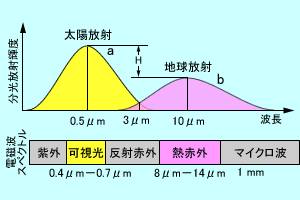 図 ae2-1 分光放射エネルギー強度 |
図 ae2-2 地球系のエネルギー代謝 |
|
|
〔光延昮毅氏による電脳経済学v3の『f用語集』の『ae2 エネルギー代謝(energy metabolism)』から〕 太陽放射と地球放射。 |
||
 〔国立環境研究所の野沢 徹氏による気候モデルを用いた地球温暖化の将来予測に関する研究から(森羅万象学校の『2003』の『過去の資料一覧』)〕 |
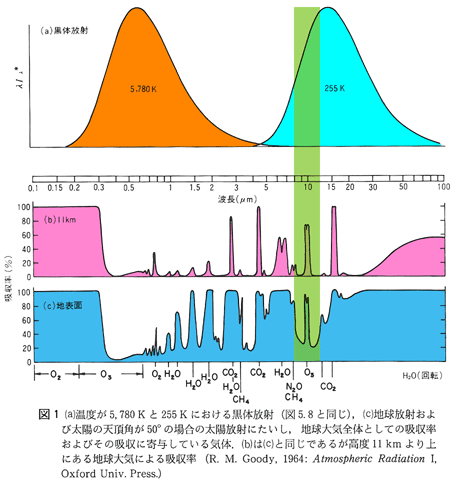 〔三輪剛史氏によるJacso Palaceの中の『気象用語集』から〕 |
